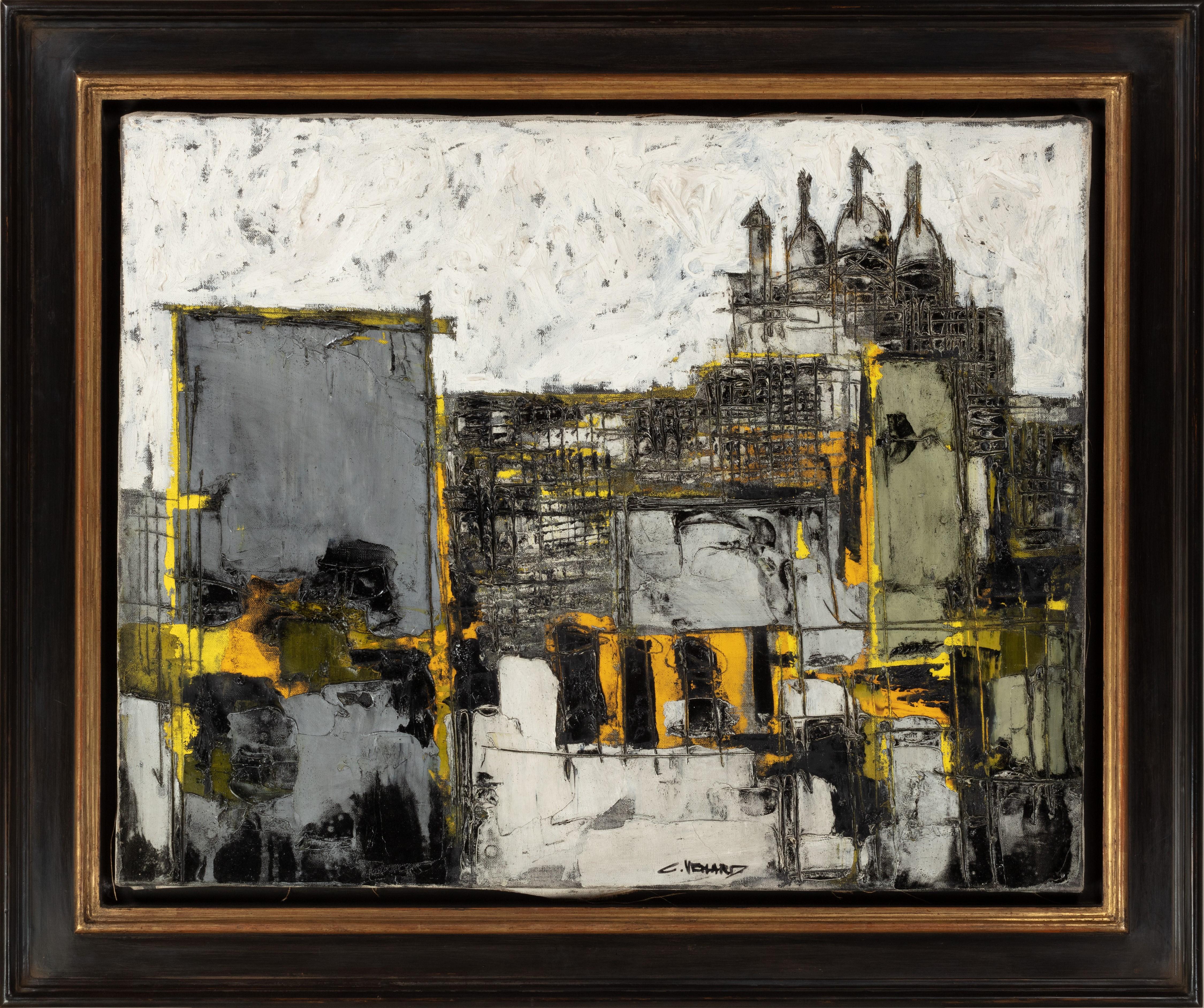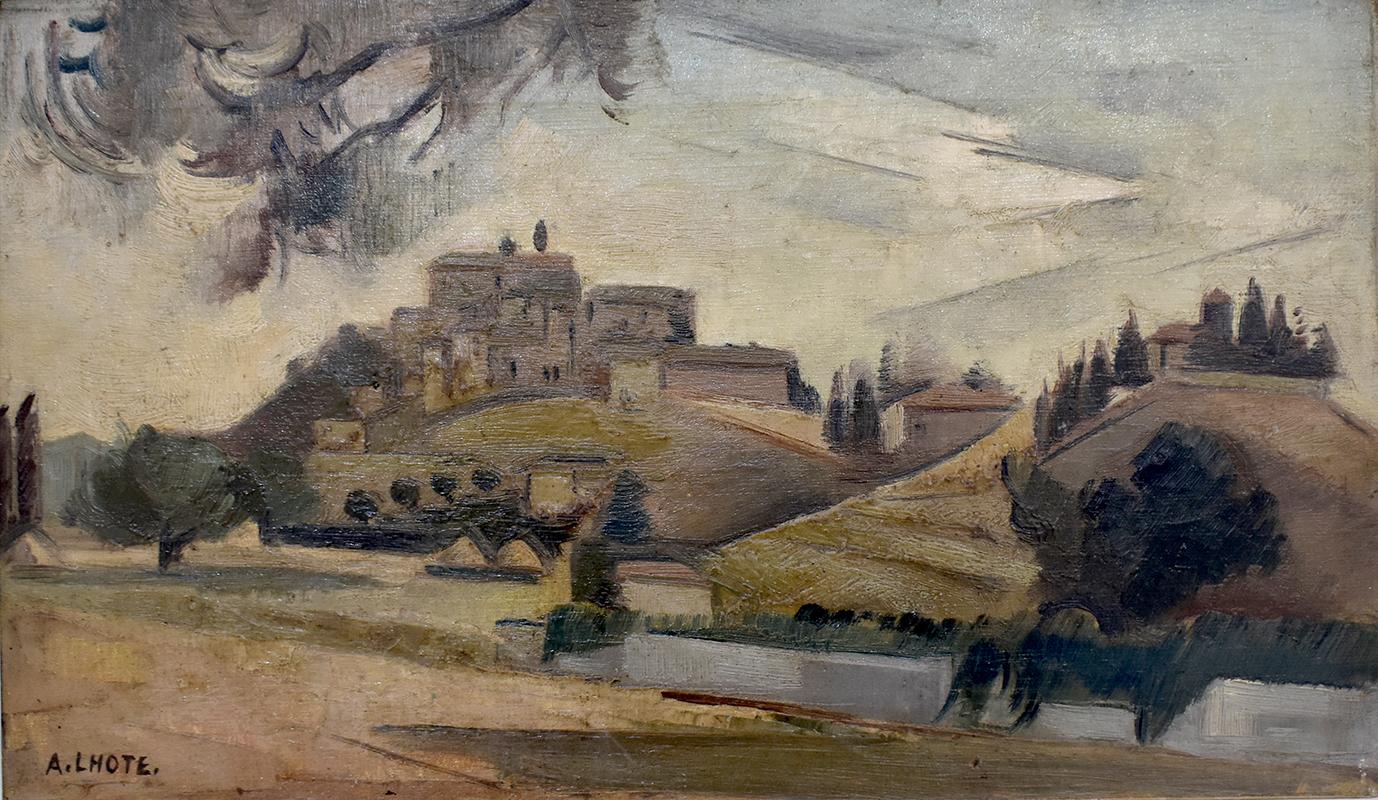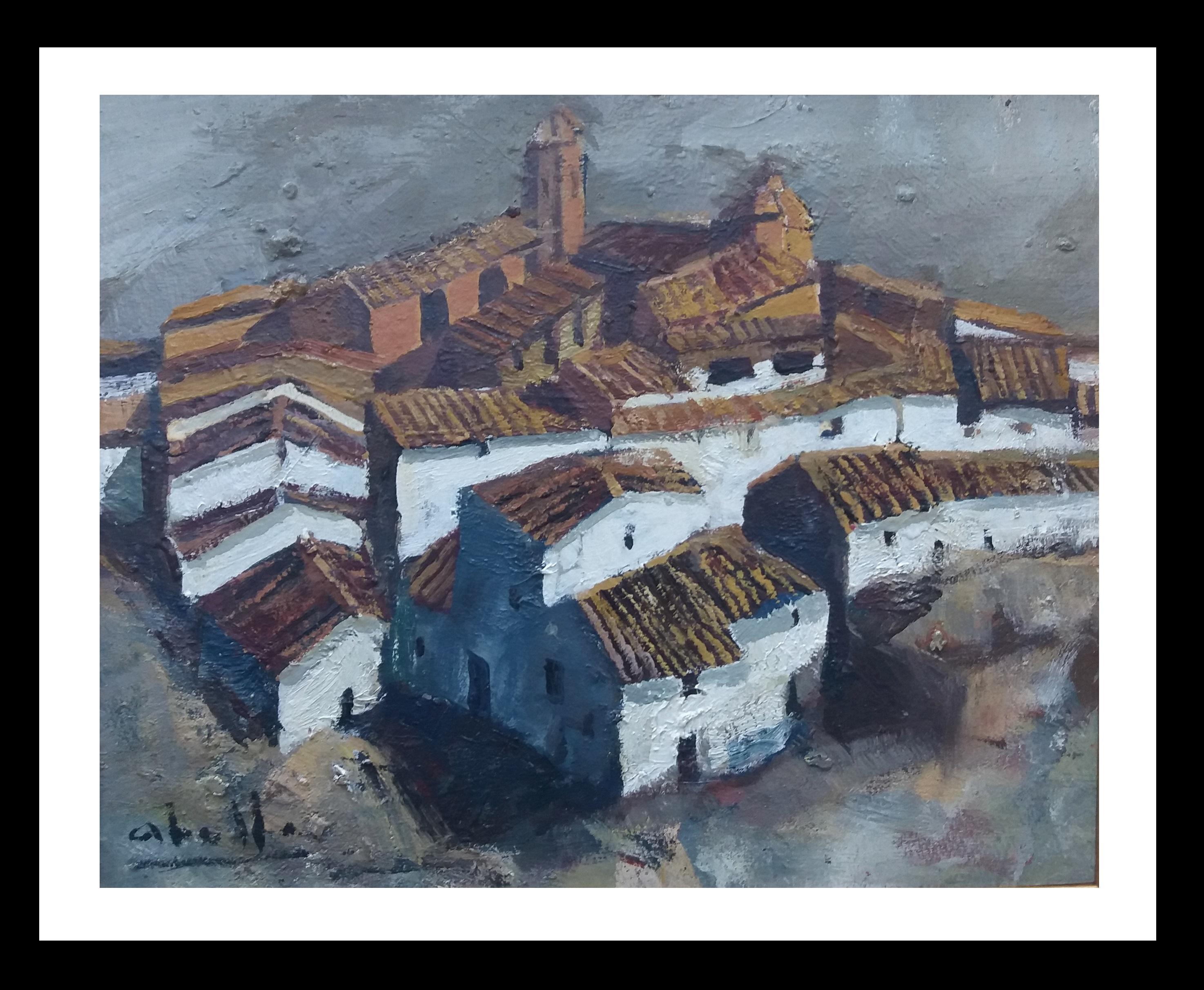Items Similar to 20th CENTURY FRENCH CUBIST LANDSCAPE OIL PAINTING - BRIGHT GREEN TREES & FIELDS
Want more images or videos?
Request additional images or videos from the seller
1 of 10
Unknown20th CENTURY FRENCH CUBIST LANDSCAPE OIL PAINTING - BRIGHT GREEN TREES & FIELDSc. 1980's
c. 1980's
About the Item
"Cubist Landscape"
French School, circa 1980's
oil painting on board, unframed
painting: 18 x 23.5 inches
Superb French oil painting from the 1980's period, depicting this lush green landscape, painted in a Cubist technique. Wonderful bright colours that bring the painting alive and ideal for so many interiors today.
Condition report:
The painting is in very good condition.
- Creation Year:c. 1980's
- Dimensions:Height: 18 in (45.72 cm)Width: 23.5 in (59.69 cm)Depth: 0.2 in (5.08 mm)
- Medium:
- Movement & Style:
- Period:
- Condition:
- Gallery Location:Cirencester, GB
- Reference Number:1stDibs: LU50936266122

About the Seller
5.0
Platinum Seller
These expertly vetted sellers are 1stDibs' most experienced sellers and are rated highest by our customers.
Established in 1989
1stDibs seller since 2016
3,402 sales on 1stDibs
Typical response time: 1 hour
- ShippingRetrieving quote...Ships From: Cirencester, United Kingdom
- Return PolicyA return for this item may be initiated within 3 days of delivery.
More From This SellerView All
- 1980's FRENCH ABSTRACT PAINTING - DRIP WORK ON LARGE PANEL - RED WHITE BLUELocated in Cirencester, Gloucestershire"Abstract" French School, 20th century painting on board, unframed board: 21.5 x 26.5 inchesCategory
Late 20th Century Cubist Landscape Paintings
MaterialsOil
- 1950's French Cubist/ Modernist Oil Painting One of the Stations of the CrossLocated in Cirencester, GloucestershireOne of the Stations of the Cross by Jean La Forgue (French 1901-1975) *see notes below oil painting on canvas, housed in original metal frame overall dimensions: 17 x 17 inches prov...Category
Mid-20th Century Cubist Figurative Paintings
MaterialsOil, Canvas
- 1950's French Cubist/ Modernist Oil Painting One of the Stations of the CrossLocated in Cirencester, GloucestershireOne of the Stations of the Cross by Jean La Forgue (French 1901-1975) *see notes below oil painting on canvas, housed in original metal frame overall dimensions: 17 x 17 inches prov...Category
Mid-20th Century Cubist Figurative Paintings
MaterialsOil, Canvas
- 1950's French Cubist/ Modernist Oil Painting One of the Stations of the CrossLocated in Cirencester, GloucestershireOne of the Stations of the Cross by Jean La Forgue (French 1901-1975) *see notes below oil painting on canvas, housed in original metal frame overall dimensions: 17 x 17 inches prov...Category
Mid-20th Century Cubist Figurative Paintings
MaterialsOil, Canvas
- 1950's French Cubist/ Modernist Oil Painting One of the Stations of the CrossLocated in Cirencester, GloucestershireOne of the Stations of the Cross by Jean La Forgue (French 1901-1975) *see notes below oil painting on canvas, housed in original metal frame overall dimensions: 17 x 17 inches prov...Category
Mid-20th Century Cubist Figurative Paintings
MaterialsOil, Canvas
- 1950's French Cubist/ Modernist Oil Painting One of the Stations of the CrossLocated in Cirencester, GloucestershireOne of the Stations of the Cross by Jean La Forgue (French 1901-1975) *see notes below oil painting on canvas, housed in original metal frame overall dimensions: 17 x 17 inches prov...Category
Mid-20th Century Cubist Figurative Paintings
MaterialsOil, Canvas
You May Also Like
- Paris Cityscape 'Sacre Coeur Sunset', Post-Cubist style, black, white, yellowBy Claude VenardLocated in Shrewsbury, Shropshire‘Sacre Coeur Sunset' is a wonderful stark cubist cityscape - full of interesting textures and angles. The scratches into the impasto created by his paint brush are also distinctive. ...Category
Late 20th Century Cubist Abstract Paintings
MaterialsCanvas, Oil
- Village in Drome / Village de la Drome - Cubism French ArtBy André LhoteLocated in London, GBThis oil painting is signed by the artist "A.Lhote." in the upper left corner. The work was painted in 1928. Note; The village is perhaps La Laupie. Provenance: This work is ac...Category
1920s Cubist Landscape Paintings
MaterialsOil
- Abella Town Original Landscape Cubist acrylic paintingBy Juan Jose Abella RubioLocated in CORAL GABLES - MIAMI, FLAbella. Original landscape cubist acrylic painting Juan Jose Abella Rubio was born in Estercuel, a hamlet anchored in the Teruel mining basin in March 1944. In his painting the och...Category
Late 20th Century Cubist Landscape Paintings
MaterialsWood, Oil
- Cubist Landscape - Mid 20th Century Spanish Sunset Oil on Board Spain PaintingLocated in Sevenoaks, GBA beautiful signed and dated 1966 cubist oil on board depicting the sun setting over a Spanish landscape, by Francisco Ramos. Excellent quality work wi...Category
1960s Cubist Landscape Paintings
MaterialsOil, Board
- "Tabac" Charles Green Shaw, Tobacco, Smoking, Park Ave Cubist, AAABy Charles Green ShawLocated in New York, NYCharles Green Shaw Tabac, circa 1935 Signed on the reverse Oil on canvasboard 5 3/4 x 8 3/4 inches Provenance: Washburn Gallery, New York, 1982 Private Collection (acquired from the above) Christie's, The Collector, October 20, 2021, Lot 307 Private Collection, Scarsdale, New York (acquired directly from the above) Literature: Hilton Kramer, "Charles Shaw: In the Minimal Tradition," New York Times, February 21, 1982, Section 2, p. 25. Charles Green Shaw was born in 1892 to a wealthy New York family. He lost both his parents at a very young age; his mother died when he was just three years old. Despite the early loss of his parents, Shaw lived the whimsical life of a New York socialite. As a beneficiary to an inheritance based in part upon the Woolworth fortune, he was brought up surrounded by the well-bred, well-groomed and well-moneyed citizens of New York’s elite social class. His social status as an adolescent was cultivated while spending summers in Newport and attending Christmas balls at Mrs. W.K. Vanderbilt’s. At age six, Shaw began to take an interest in drawing, and by nine, he was known to have a fondness for sketching historical costumes. After graduating from Yale University in 1914, Shaw spent a year studying at Columbia University’s School of Architecture. Subsequently he served for eighteen months as a Lieutenant in World War I. After his service, Shaw returned to New York and tried his hand as a businessman selling real estate, but his attempt was short lived. In the early 1920s, Shaw began his career as a journalist and novelist. He achieved professional success, writing consistently for magazines such as The New Yorker, Vanity Fair and The Smart Set. Shaw’s writing was a record of his approvals and disapprovals of the social crowd to which he belonged. His profession along with his social pedigree, brought him in contact with a number of the most significant figures of the 1920s such as, F. Scott Fitzgerald, Sinclair Lewis, George Gershwin, George Jean Nathan and the American artist George Luks. Some of his profiles included celebrity caricatures used as illustrations, these were the publics’ first look at Shaw’s artistic ability. In 1928, a collection of Shaw’s articles and interviews were published in one volume titled, The Low Down. Just previous to the stock market crash and the end of the Jazz Age, Shaw left New York and traveled to Paris and London. He arrived in Paris in 1929. In an autobiographical note Shaw suggests it was on this trip when he first began to paint seriously. London also acted as a great source of motivation for the budding artist. He began to sketch everyday in St. James’s Park, making large pastels of its vistas in the style of Cezanne. When he returned to New York in 1932, Shaw considered himself a painter. Success for Shaw came quickly with his first solo exhibition mounted at the Valentine Gallery in 1934. The following year Albert Eugene Gallatin included works by the artist in an unprecedented solo exhibition at his Gallery of Living Art at New York University. Shaw further cemented his reputation as an artist through his association and friendship with fellow abstract artists Morris and Gallatin. The trio soon was regarded as ‘the Park Avenue Cubists’. As a founding member of the American Abstract Artists, Shaw became an impassioned defender of the style. His 1938 essay in the American Abstract Artists yearbook, “A Word to the Objector”, acted as a defense against those who failed to see the illustrative quality of abstract art and scolded those who disregarded American artists as serious Abstractionists. He was also an influential force at the Museum of Modern Art, where he sat on the Advisory Board from 1936 to 1941. In the later years of Shaw’s life he continued to produce abstract paintings, yet in a more private manner. He was known to be a reserved man— a ‘gentleman’; not much is known about his personal life in these later years. During this time he maintained his career as a writer, publishing the well-known children’s book, It Looked Like Spilt Milk in 1940 and two books of poems in 1959 and 1962. In 1974, Shaw died...Category
1930s Cubist Landscape Paintings
MaterialsOil, Board
- The Fishermen's Chapel - 20th Century Cubist Houses Modern British Oil PaintingLocated in Sevenoaks, GBA beautiful 1950's cubist oil on board depicting houses with a fishermen's chapel by Jack Metson. Excellent quality and a leading example of the artists work. Signed lower left and i...Category
Mid-20th Century Cubist Landscape Paintings
MaterialsOil, Board
Recently Viewed
View AllMore Ways To Browse
So Green
French Landscape 1980s
French Landscape Cubist
Oil Painting Cubist Landscape
Vintage Oil Painting On Board
1930s British Paintings
Brown Framed Botanical
Large British Painting Modern
Native American Southwest
Scenes Of Ireland
French Landscape 1980s
Pacific Beach
Coast Of Maine
Sur Mer Painting
Hudson River School Gallery
Vintage Grove
Vintage Gold Framed Art
Notre Dame Paris Painting




